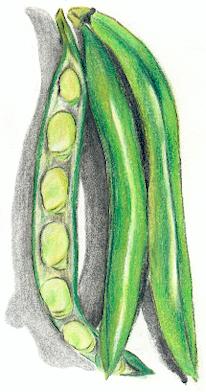
'Aquadulce Claudia' - a popular
variety for November sowing
Broad Bean
November is the month in which vegetable gardeners traditionally sow a row or two of broad bean seeds - especially in the South or in a well-sheltered garden.
Broad beans sown at this time of the year are more or less immune to the problems that beset spring sowings: they tend not to be eaten by mice, they mature before black fly arrive on the scene in early summer and their steady growth throughout the winter means that they do not make much demand on the soil. They also produce an early crop - usually around June - before most of the Spring-sown vegetables are available to be picked.
The one problem is that they may not survive an exceptionally bad winter - especially in the North or in exposed or water logged locations. This means that you have to be prepared to make another sowing of broad beans in early to mid March if necessary.
The seeds need to be planted two to three inches deep. This is best done on a day when the soil is not too wet and sticky. The easiest way to plant the seeds is to make individual holes with a dibber or thick stick, to drop the seed in and then to fill in the hole with the surrounding soil.
If you are planting quite a large area, plant double rows about 2 feet (60 cm) apart. The two lines forming the double row should be 9 inches (25 cm) apart and the seeds should be 6 inches (15 cm) apart in the rows.
Hoe between the plants from time to time when they are small.
In exposed positions the mature plants may be blown over by strong winds
and will need to be supported by sticks.